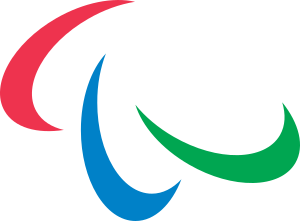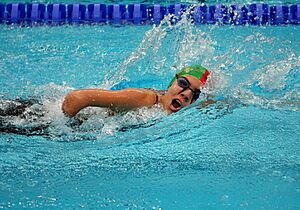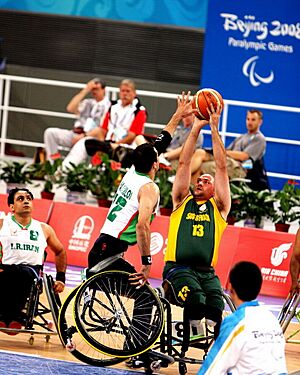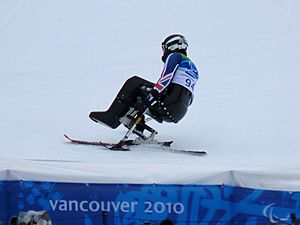Paralympic sports facts for kids
The Paralympic sports are all the different sports played at the Summer and Winter Paralympic Games. These games are a huge international event for athletes who have physical disabilities or intellectual impairments. This includes athletes with conditions like mobility issues, amputations, blindness, and cerebral palsy.
As of 2020, the Summer Paralympics had 22 sports and 539 medal events. The Winter Paralympics had 5 sports and about 80 events. The types and number of events can change for each Paralympic Games. All these sports are managed by the International Paralympic Committee (IPC) and other sports groups around the world.
Contents
How the Paralympics Started
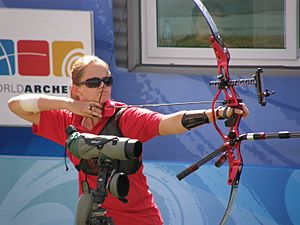
Organized sports for people with physical disabilities began as a way to help them recover after injuries. After World War II, many soldiers and civilians were injured. Sports became a very important part of their recovery programs.
This idea of using sports for recovery grew into fun activities and then into serious competitions. A key person in this movement was Ludwig Guttmann. He worked at Stoke Mandeville Hospital in England. In 1948, when the Olympic Games were happening in London, he organized a sports competition for wheelchair athletes at his hospital. This event was the start of the Stoke Mandeville Games, which later became the modern Paralympic Games.
Who Organizes Paralympic Sports?
The International Paralympic Committee (IPC) is the main group that leads Paralympic sports worldwide. They directly manage nine sports and are in charge of the Paralympic Games and other big events for athletes with different disabilities.
Other international groups also help manage specific sports for certain disability groups. For example, there are groups for athletes who use wheelchairs or have amputations, those who are blind, or those with intellectual disabilities. Some sports federations, like the one for horse riding, also include disabled athletes in their events.
At a national level, many organizations, including National Paralympic Committees, help organize Paralympic sports in their own countries.
Understanding Disability Categories

Athletes in Paralympic sports are put into ten main groups based on their type of disability. This helps make sure competitions are fair.
Physical Impairment
There are eight types of physical impairments:
- Impaired muscle power - This means muscles are weaker, like in one arm or leg, or the lower body. This can happen from spinal cord injuries or conditions like polio.
- Impaired passive range of movement - This is when a person cannot move one or more joints fully. This does not include temporary conditions like arthritis.
- Loss of limb or limb deficiency - This means a part of an arm or leg is missing, either from an amputation due to illness or injury, or because it was not fully formed at birth.
- Leg-length difference - One leg is much shorter than the other due to a birth condition or an injury.
- Short stature - A person is much shorter than average because their bones or cartilage did not grow properly.
- Hypertonia - This is when muscles are too stiff and hard to stretch. It can be caused by damage to the brain or spinal cord, like with cerebral palsy.
- Ataxia - This means a person has trouble with muscle coordination, making movements shaky or unsteady. This can be seen in conditions like cerebral palsy.
- Athetosis - This involves uncontrolled, jerky movements and difficulty holding a steady posture. This is also often seen in cerebral palsy.
Visual Impairment
This group includes athletes who have some vision but are considered legally blind, all the way to those who are completely blind. For athletes with visual impairment, their sighted guides are a very important part of the team. These guides, along with sighted goalkeepers in 5-a-side football, can even earn their own medals since 2012.
Intellectual Disability
These athletes have a significant difficulty with thinking and learning, which was diagnosed before they turned 18. The IPC mainly focuses on athletes with physical disabilities, but intellectual disability has been included in some Paralympic Games. The Special Olympics World Games are also for people with intellectual disabilities.
The disability category helps decide who athletes compete against and which sports they can play. Some sports are open to many disability types (like cycling), while others are only for one (like Five-a-side football). In some sports, athletes from different categories compete separately, but in others, they compete against each other. Events are often named with the disability category, like "Men's Swimming Freestyle S1" for athletes with a severe physical impairment.
Fair Play Through Classification
A very important part of Paralympic sport is classification. This system helps make sure that athletes compete against others who have similar disabilities or similar levels of physical ability. It's a bit like how some sports use weight classes or age groups to make competitions fair.
Athletes go through different tests to be classified. These tests depend on their disability and the sport they play. They might have a physical exam, tests to see how they perform certain sports movements, and observations during practice and competition. Each sport has its own specific classification rules.
Summer Paralympic Sports
The Summer Paralympics feature a wide range of sports. Here are some of the current ones:
- Archery
- Athletics (track and field)
- Badminton
- Boccia
- Canoeing
- Cycling (track and road)
- Equestrian (horse riding)
- Football 5-a-Side (for visually impaired athletes)
- Goalball (for visually impaired athletes)
- Judo (for visually impaired athletes)
- Powerlifting
- Rowing
- Shooting
- Swimming
- Table tennis
- Taekwondo
- Triathlon
- Volleyball
- Wheelchair basketball
- Wheelchair fencing
- Wheelchair rugby
- Wheelchair tennis
Future Summer Sports
Paraclimbing (a type of sport climbing) is planned to be added to the 2028 Summer Paralympics in Los Angeles.
Winter Paralympic Sports
The Winter Paralympics also have exciting sports:
- Alpine skiing
- Para ice hockey
- Nordic skiing (includes Biathlon and Cross-country skiing)
- Wheelchair curling
- Para-Snowboarding
Images for kids
See also
 In Spanish: Deportes paralímpicos para niños
In Spanish: Deportes paralímpicos para niños


